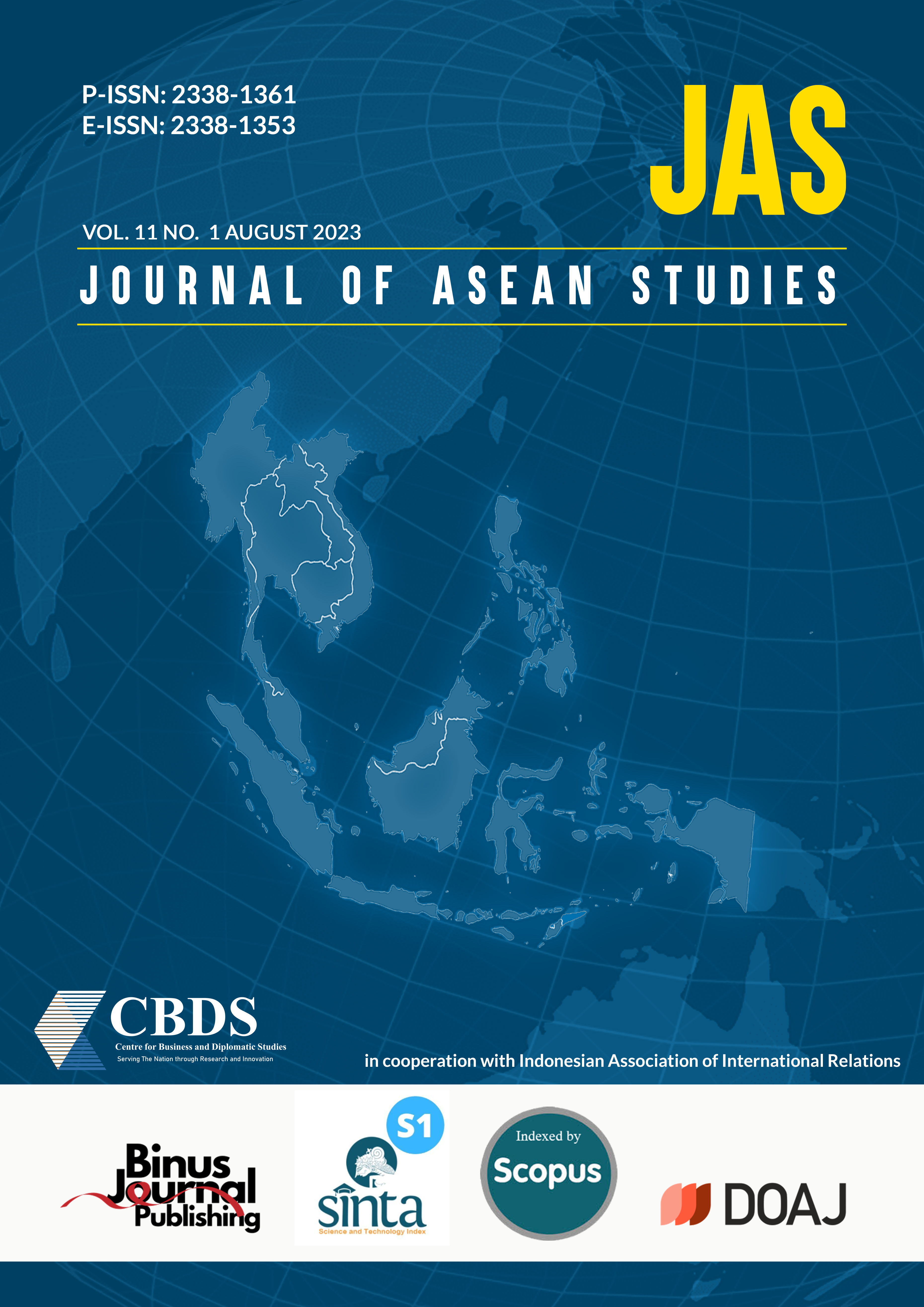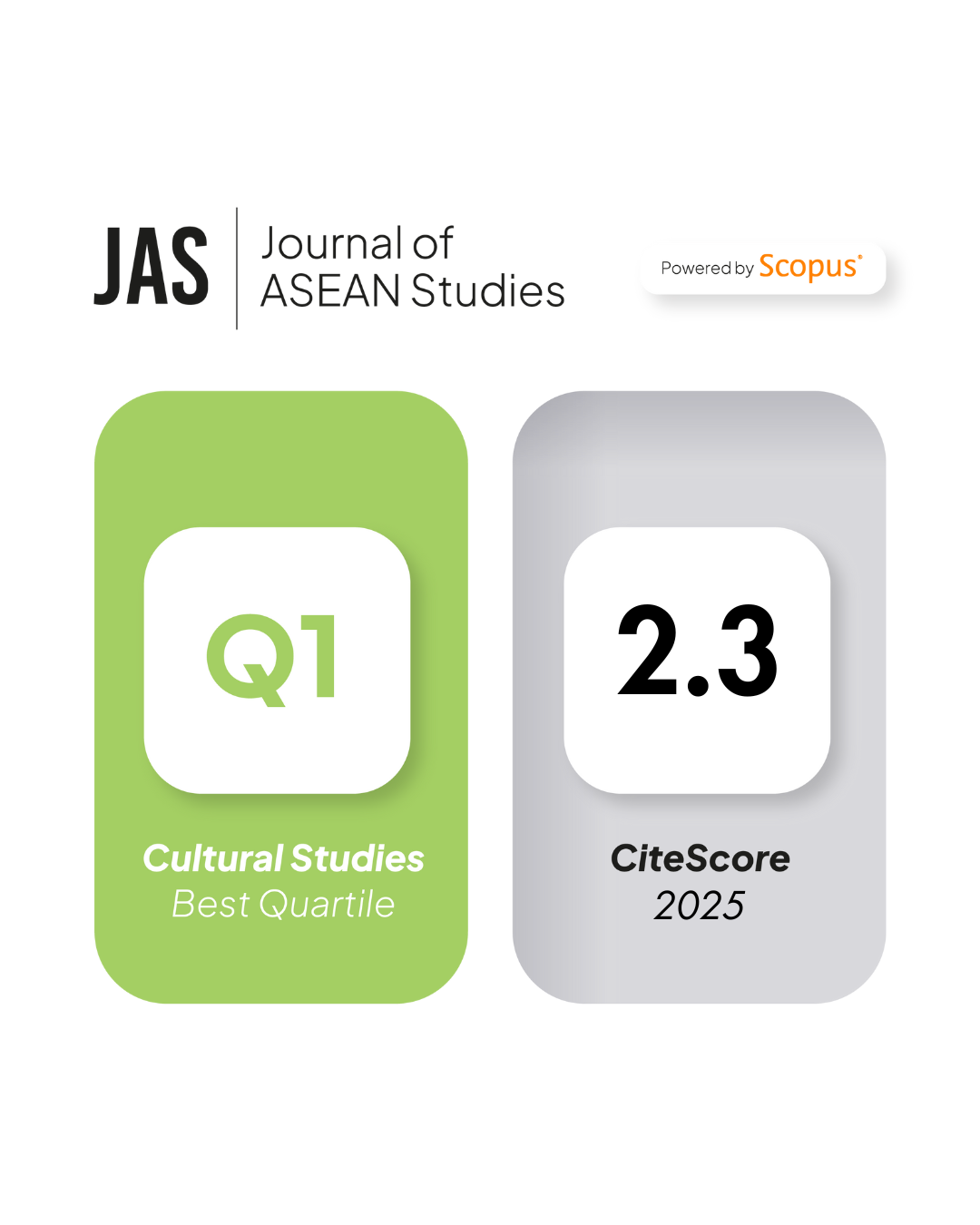Going Back with Glee: A Case Study of Indonesian Migrant Workers Engaging in Circular Migration
DOI:
https://doi.org/10.21512/jas.v11i1.8610Keywords:
case study, circular migration, Indonesia, migrant workers, migrationAbstract
Driven by a wide range of social and cultural forces, circular migration has become a prominent phenomenon in the contemporary world, and it is especially common among Indonesian migrant workers. The research delved into what pushes Indonesian migrant workers to going back to host countries for employment after returning to their home country. A case study approach was employed by which a total of 24 semi-structured interviews were conducted with Indonesian migrant workers from Blitar, Malang, Ponorogo, and Tulungagung in East Java, Indonesia. The research reveals that non-monetary incentives such as supportive and amicable workplace environments, including the possibility of career advancements and adequate accommodations, as well as productive and family-oriented communities, act as important motivators for Indonesian migrant workers to go back to host countries. Furthermore, the research adds to the widening topography of migration studies by which it provides a broader picture in painting the “human†rationality behind circular migration in Global South.
References
Acharya, A. K. (2021). Caste-based migration and exposure to abuse and exploitation: Dadan labour migration in India. Contemporary Social Science, 16(3), 371-383. https://doi.org/10.1080/21582041.2020.1855467
Akay, P. A., & Ahmadi, N. (2022). The Work Environment of Immigrant Employees in Sweden—a Systematic Review. Journal of International Migration and Integration, 1–34.
Anwar, R. P. (2015). Return migration and local development in Indonesia. 현대사회와다문화, 5(2), 224–257.
Blumenstock, J. E., Chi, G., & Tan, X. (2019). Migration and the value of social networks. [G2LM|LIC Working Paper No. 60]. Institute of Labor Economics.
Borras, S. M., Franco, J. C., Ra, D., Kramer, T., Kamoon, M., Phyu, P., …, Ye, J. (2022). Rurally rooted cross-border migrant workers from Myanmar, Covid-19, and agrarian movements. Agriculture and Human Values, 39(1), 315–338. https://doi.org/10.1007/s10460-021-10262-6
Boustan, L. P., Fishback, P. V., & Kantor, S. (2010). The effect of internal migration on local labor markets: American cities during the Great Depression. Journal of Labor Economics, 28(4), 719-746. https://doi.org/10.1086/653488
Brennan, D. (2014). Trafficking, scandal, and abuse of migrant workers in Argentina and the United States. The ANNALS of the American Academy of Political and Social Science, 653(1), 107-123. https://doi.org/10.1177/0002716213519239
Bylander, M. (2020). Destination debts: Local and translocal loans in the migrant experience. Geoforum, 137, 194-202. https://doi.org/10.1016/j.geoforum.2020.06.015
Caxaj, C. S., & Cohen, A. (2019). “I will not leave my body hereâ€: Migrant farmworkers’ health and safety amidst a climate of coercion. International Journal of Environmental Research and Public Health, 16(15). https://doi.org/10.3390%2Fijerph16152643
Cheo, R. (2017). Migrant workers and workplace bullying in urban China. Social Indicators Research, 132, 87-115. https://doi.org/10.1007/s11205-015-1214-0
Chowdhury, M. B., & Chakraborty, M. (2021). The impact of COVID-19 on the migrant workers and remittances flow to Bangladesh. South Asian Survey, 28(1), 38–56. https://doi.org/10.1177/0971523121995365
Constant, A. F. (2020). Time-space dynamics of return and circular migration. Handbook of Labor, Human Resources and Population Economics, 1–40. http://dx.doi.org/10.1007/978-3-319-57365-6_107-1
Constant, A. F., Nottmeyer, O., & Zimmermann, K. F. (2013). The economics of circular migration. In International Handbook on the Economics of Migration (pp. 55–74). Edward Elgar Publishing.
Creswell, J. W., & Poth, C. N. (2016). Qualitative inquiry and research design: Choosing among five approaches. Sage publications.
Dewen, W., Fang, C., & Guoqing, Z. (2010). Factors Influencing Migrant Workers’ Employment and Earnings—The Role of Education and Training. Social Sciences in China, 31(3), 123–145. https://doi.org/10.1080/02529203.2010.503078
Digidiki, V., & Bhabha, J. (2018). Sexual abuse and exploitation of unaccompanied migrant children in Greece: Identifying risk factors and gaps in services during the European migration crisis. Children and Youth Services Review, 92, 114-121. https://doi.org/10.1016/j.childyouth.2018.02.040
Dolfin, S., & Genicot, G. (2010). What do networks do? The role of networks on migration and “coyote†use. Review of Development Economics, 14(2), 343–359. https://doi.org/10.1111/j.1467-9361.2010.00557.x
Farashah, A. D., & Blomquist, T. (2019). Exploring employer attitude towards migrant workers: Evidence from managers across Europe. Evidence-Based HRM: A Global Forum for Empirical Scholarship.
Fitzgerald, S., Chen, X., Qu, H., & Sheff, M. G. (2013). Occupational injury among migrant workers in China: a systematic review. Injury Prevention, 19(5), 348–354. https://doi.org/10.1136/injuryprev-2012-040578
Forde, C., & MacKenzie, R. (2009). Employers’ use of lowâ€skilled migrant workers: Assessing the implications for human resource management. International Journal of Manpower, 30, 437-452. http://dx.doi.org/10.1108/01437720910977643
Gallagher, A. T. (2015). Migrant smuggling.
Garip, F., & Asad, A. L. (2016). Network effects in Mexico–US migration: Disentangling the underlying social mechanisms. American Behavioral Scientist, 60(10), 1168–1193. https://doi.org/10.1177/0002764216643131
Guérin, I., & Venkatasubramanian, G. (2020). The socio-economy of debt. Revisiting debt bondage in times of financialization. Geoforum, 137, 174-184. https://doi.org/10.1016/j.geoforum.2020.05.020
Global Forum on Migration and Development (GFMD). (2007). Global Forum on Migration and Development (GFMD). Retrieved from https://www.iom.int/global-forum-migration-and-development-gfmd.
Guba, E. G., & Lincoln, Y. S. (2005). Paradigmatic controversies, contradictions, and emerging confluences.
Hargreaves, S., Rustage, K., Nellums, L. B., McAlpine, A., Pocock, N., Devakumar, D., …, Himmels, J. W. (2019). Occupational health outcomes among international migrant workers: a systematic review and meta-analysis. The Lancet Global Health, 7(7), e872–e882. https://doi.org/10.1016/S2214-109X(19)30204-9
Harkins, B., & Lindgren, D. (2018). Labour migration in the ASEAN region: Assessing the social and economic outcomes for migrant workers. Last Visited, 12(1).
Harvey, C., Thompson, S., Otis, E., & Willis, E. (2020). Nurses’ views on workload, care rationing and work environments. Journal of Nursing Management, 28(4), 912–918. https://doi.org/10.1111/jonm.13019
Hoang, L. A. (2020). Debt and (un)freedoms: The case of transnational labour migration from Vietnam. Geoforum, 116, 33–41. http://dx.doi.org/10.1016/j.geoforum.2020.08.001
Hombrados-Mendieta, I., Millán-Franco, M., Gómez-Jacinto, L., Gonzalez-Castro, F., Martos-Méndez, M. J., & GarcÃa-Cid, A. (2019). Positive influences of social support on sense of community, life satisfaction and the health of immigrants in Spain. Frontiers in Psychology. https://doi.org/10.3389/fpsyg.2019.02555
Ibrahim, S. S., Ozdeser, H., Cavusoglu, B., & Shagali, A. A. (2021). Rural migration and relative deprivation in agro-pastoral communities under the threat of cattle rustling in Nigeria. SAGE Open, 11(1). https://doi.org/10.1177/2158244020988856
Jain, P. C., & Oommen, G. Z. (2016). South Asian Migration to Gulf Countries: History, Policies, Development (1st Ed.). London: Routledge.
Janta, H., Ladkin, A., Brown, L., & Lugosi, P. (2011). Employment experiences of Polish migrant workers in the UK hospitality sector. Tourism Management, 32(5), 1006–1019. http://dx.doi.org/10.1016/j.tourman.2010.08.013
Jureidini, R. (2010). Trafficking and contract migrant workers in the Middle East. International Migration, 48(4), 142-163. https://doi.org/10.1111/j.1468-2435.2010.00614.x
Kiranantika, A. (2021). Social Networks : The Survival Strategy Of Indonesian Migrant Workers In Hong Kong. Komunitas: International Journal of Indonesian Society and Culture, 13(1), 100–107. https://doi.org/10.15294/komunitas.v13i1.27021
Koh, D. (2020). Migrant workers and COVID-19. Occupational and Environmental Medicine, 77(9), 634–636. https://doi.org/10.1136/oemed-2020-106626
Lainez, N. (2020). Debt, trafficking and safe migration: The brokered mobility of Vietnamese sex workers to Singapore. Geoforum, 137, 164-173. https://doi.org/10.1016/j.geoforum.2020.01.021
Lan, P.-C. (2001). Among women: Migrant domestics and their Taiwanese employers across generations. Berkeley Collection of Working and Occasional Papers, 37.
Le, H., Jiang, Z., & Nielsen, I. (2018). Cognitive cultural intelligence and life satisfaction of migrant workers: The roles of career engagement and social injustice. Social Indicators Research, 139(1), 237–257. https://link.springer.com/article/10.1007%2Fs11205-016-1393-3
Loganathan, T., Rui, D., Ng, C.-W., & Pocock, N. S. (2019). Breaking down the barriers: Understanding migrant workers’ access to healthcare in Malaysia. PloS One, 14(7). https://doi.org/10.1371/journal.pone.0218669
Lowe, M. A., Prapanjaroensin, A., Bakitas, M. A., Hites, L., Loan, L. A., Raju, D., & Patrician, P. A. (2020). An exploratory study of the influence of perceived organizational support, coworker social support, the nursing practice environment, and nurse demographics on burnout in palliative care nurses. Journal of Hospice & Palliative Nursing, 22(6), 465–472. https://doi.org/10.1097/njh.0000000000000686
Luksyte, A., Spitzmueller, C., & Rivera-Minaya, C. Y. (2014). Factors relating to wellbeing of foreign-born Hispanic workers. Journal of Managerial Psychology, 29(6), 685-704. https://psycnet.apa.org/doi/10.1108/JMP-10-2012-0322
MacKenzie, R., & Forde, C. (2009). The rhetoric of the ‘good worker’ versus the realities of employers’ use and the experiences of migrant workers. Work, Employment and Society, 23(1), 142–159. https://doi.org/10.1177/0950017008099783
Majid, Z., Welch, C., Davies, J., & Jackson, T. (2020). Global frailty: the role of ethnicity, migration and socioeconomic factors. Maturitas, 139, 33–41. https://doi.org/10.1016%2Fj.maturitas.2020.05.010
Martyn, H. L. (2018). Voices of Indonesian migrant workers at home and abroad. Asian Social Science, 14(8), 119–131. http://dx.doi.org/10.5539/ass.v14n8p119
Mas’udah, S. (2020). Remittances and lifestyle changes among Indonesian overseas migrant workers’ families in their hometowns. Journal of International Migration and Integration, 21(2), 649–665. https://doi.org/10.1007/s12134-019-00676-x
Maxwell, J. A. (2008). Designing a qualitative study (Vol. 2, pp. 214-253). The SAGE handbook of applied social research methods.
Meng, L. I., Christopher, G. A. N., Wanglin, M. A., & Jiang, W. (2020). Impact of cash crop cultivation on household income and migration decisions: Evidence from low-income regions in China. Journal of Integrative Agriculture, 19(10), 2571–2581. https://doi.org/10.1016/S2095-3119(20)63161-6
Miles, M. B., Huberman, A. M., & Saldaña, J. (2018). Qualitative Data Analysis: A Methods Sourcebook. California: SAGE Publications.
Moniruzzaman, M., & Walton-Roberts, M. (2018). Migration, debt and resource backwash: how sustainable is Bangladesh-Gulf circular migration? Migration and Development, 7(1), 85-103. https://doi.org/10.1080/21632324.2017.1358799
Moyce, S. C., & Schenker, M. (2018). Migrant workers and their occupational health and safety. Annual Review of Public Health, 39, 351–365. https://doi.org/10.1146/annurev-publhealth-040617-013714
Mucci, N., Traversini, V., Giorgi, G., Tommasi, E., De Sio, S., & Arcangeli, G. (2019). Migrant workers and psychological health: A systematic review. Sustainability, 12(1), 120. https://doi.org/10.3390/su12010120
Munshi, K. (2014). Community networks and migration. In Y. Bramoullé, A. Galleoti, & B. Rogers (Eds.), The Oxford Handbook of the Economics of Networks (pp. 1-22). Oxford University Press. https://doi.org/10.1093/oxfordhb/9780199948277.001.0001
Neuman, W. L., & Robson, K. (2014). Basics of Social Research. Pearson Canada Toronto.
Ollus, N. (2016). Forced flexibility and exploitation: experiences of migrant workers in the cleaning industry. Nordic journal of working life studies, 6(1), 25-45. https://doi.org/10.19154/njwls.v6i1.4908
Oun, M. A., & Bach, C. (2014). Qualitative research method summary. Qualitative Research, 1(5), 252-258.
Parker, C., Scott, S., & Geddes, A. (2019). Snowball Sampling. SAGE Research Methods Foundations.
Piper, N., & Roces, M. (2004). Wife or Worker?: Asian Women and Migration. Rowman & Littlefield Publishers.
Piracha, M., & Vadean, F. (2010). Return migration and occupational choice: Evidence from Albania. World Development, 38(8), 1141–1155. https://doi.org/10.1016/j.worlddev.2009.12.015
Rajendran, D., Ng, E. S., Sears, G., & Ayub, N. (2020). Determinants of migrant career success: A study of recent skilled migrants in Australia. International Migration, 58(2), 30–51. http://dx.doi.org/10.1111/imig.12586
Ravasi, C., Salamin, X., & Davoine, E. (2015). Cross-cultural adjustment of skilled migrants in a multicultural and multilingual environment: an explorative study of foreign employees and their spouses in the Swiss context. The International Journal of Human Resource Management, 26(10), 1335–1359. https://psycnet.apa.org/doi/10.1080/09585192.2014.985328
Sayono, J., Utami, I. W. P., & Ayundasari, L. (2018). Migrant workers and socio-economic changes. Masyarakat, Kebudayaan dan Politik, 31(2), 176–189. https://doi.org/10.20473/mkp.V31I22018.176-189
Shah, N. M. (2013). Labour migration from Asian to GCC countries: Trends, patterns and policies. Middle East Law and Governance, 5(1–2), 36–70. http://dx.doi.org/10.1163/18763375-00501002
Shamsuddin, M., Katsaiti, M. S., & El Anshasy, A. A. (2022). Income rank and income concerns: What correlates with international migration intentions? Economic Analysis and Policy, 75, 490–505. https://doi.org/10.1016/j.eap.2022.06.004
Sherry, V. N. (2004, July 13). Bad dreams: Exploitation and abuse of migrant workers in Saudi Arabia. Human Rights Watch. https://www.hrw.org/report/2004/07/13/bad-dreams/exploitation-and-abuse-migrant-workers-saudi-arabia
Sonmez, S., Apostolopoulos, Y., Tran, D., & Rentrope, S. (2011). Human rights and health disparities for migrant workers in the UAE. Health & Hum. Rts., 13, 17.
Sorauren, I. F. (2000). Non-monetary incentives: Do people work only for money? Business Ethics Quarterly, 925-944. https://doi.org/10.2307/3857840
Spitzer, D. L., & Piper, N. (2014). Retrenched and returned: Filipino migrant workers during times of crisis. Sociology, 48(5), 1007–1023. https://doi.org/10.1177/0038038514540579
Sricharoen, T. (2020). Migration and Remittances: Evidence from Cambodia, Myanmar and Lao Migrant Workers. Global Academy of Training and Research (GATR) Enterprise.
Stake, R. E. (2005). Qualitative case studies.
Stake, R. E. (2010). Qualitative research: Studying how things work.
Stark, O., Micevska, M., & Mycielski, J. (2009). Relative poverty as a determinant of migration: Evidence from Poland. Economics Letters, 103(3), 119–122.
Sterud, T., Tynes, T., Mehlum, I. S., Veiersted, K. B., Bergbom, B., Airila, A., …, Flyvholm, M. A. (2018). A systematic review of working conditions and occupational health among immigrants in Europe and Canada. BMC Public Health, 18(1), 1–15. https://doi.org/10.1186/s12889-018-5703-3
Stevens, M., Hussein, S., & Manthorpe, J. (2012). Experiences of racism and discrimination among migrant care workers in England: findings from a mixed-methods research project. Ethnic and racial studies, 35(2), 259-280. https://doi.org/10.1080/01419870.2011.574714
Tabuga, A. D. (2018). A probe into the Filipino migration culture: What is there to learn for policy intervention? [Discussion Paper Series No. 2018-02]. Research Information Department, Philippine Institute for Development Studies.
Thomas, M. J. (2019). Employment, education, and family: Revealing the motives behind internal migration in Great Britain. Population, Space and Place, 25(4). https://doi.org/10.1002/psp.2233
Timonen, V., & Doyle, M. (2010). Migrant care workers’ relationships with care recipients, colleagues and employers. European Journal of Women’s Studies, 17(1), 25–41. https://doi.org/10.1177/1350506809350859
Triandafyllidou, A., & Marchetti, S. (2013). Migrant domestic and care workers in Europe: New patterns of circulation?. Journal of Immigrant & Refugee Studies, 11(4), 339-346. https://doi.org/10.1080/15562948.2013.822750
Uhlendorff, A., & Zimmermann, K. F. (2014). Unemployment dynamics among migrants and natives. Economica, 81(322), 348-367. https://doi.org/10.1111/ecca.12077
Urbański, M. (2022). Comparing push and pull factors affecting migration. Economies, 10(1), 21. http://dx.doi.org/10.3390/economies10010021
Wanninayake, S. (2016). Sri Lankan women migrant workers and role of family and kinship networks. Journal of Advances in Humanities and Social Sciences, 1(2), 14–23.
Weine, S., Golobof, A., Bahromov, M., Kashuba, A., Kalandarov, T., Jonbekov, J., & Loue, S. (2013). Female migrant sex workers in Moscow: gender and power factors and HIV risk. Women & Health, 53(1), 56–73. https://doi.org/10.1080%2F03630242.2012.739271
Wickramasekara, P. (2008). Globalisation, international labour migration and the rights of migrant workers. Third World Quarterly, 29(7), 1247-1264. https://doi.org/10.1080/01436590802386278
Witte, N., & Guedes Auditor, J. (2021). Affluent lives beyond the border? Individual wage change through migration. In M. Erlinghagen, A. Ette, N. F. Schneider, & N. Witte (Eds.), The Global Lives of German Migrants (pp. 121–138). Springer, Cham.
World Bank Group. (2017). Migrating to Opportunity: Overcoming Barriers to Labor Mobility in Southeast Asia. Retrieved from https://www.worldbank.org/en/region/eap/publication/migrating-to-opportunity-overcoming-barriers-to-labor-mobility-in-southeast-asia.
Yin, R. K. (2006). Mixed methods research: Are the methods genuinely integrated or merely parallel. Research in the Schools, 13(1), 41-47.
Zanabazar, A., Kho, N. S., & Jigjiddorj, S. (2021). The push and pull factors affecting the migration of Mongolians to the Republic of South Korea. SHS Web of Conferences, 90, 1023.
Zewdu, G. A. (2018). Ethiopian female domestic labour migration to the Middle East: Patterns, trends, and drivers. African and Black Diaspora: An International Journal, 11(1), 6-19. https://doi.org/10.1080/17528631.2017.1342976
Downloads
Published
How to Cite
Issue
Section
License
Copyright (c) 2023 Dr. Erna Setijaningrum, Dr. Asiyah Kassim, Dr. Rochyati Triana, Reza Dzulfikri

This work is licensed under a Creative Commons Attribution-NonCommercial 4.0 International License.






















